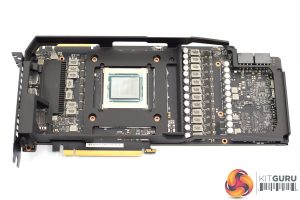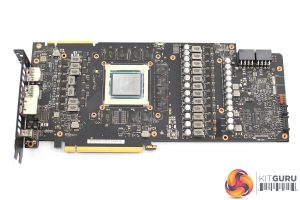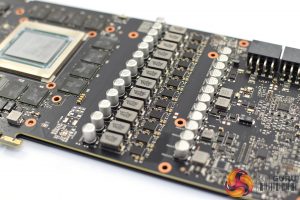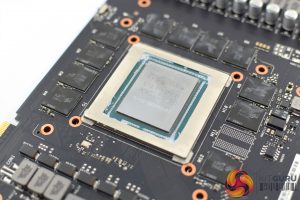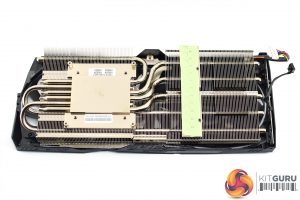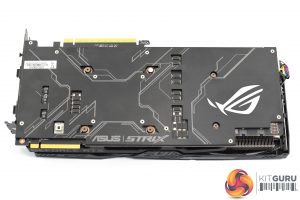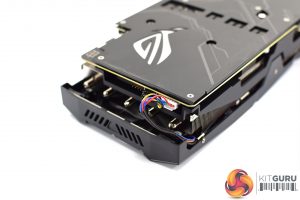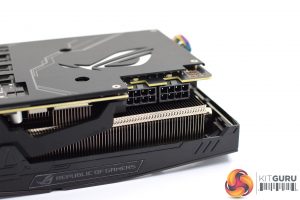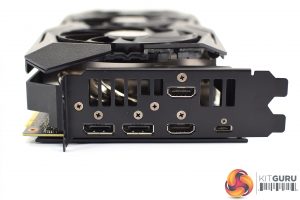The ASUS ROG RTX 2080 Ti Strix OC ships in essentially an identical box to its smaller brother, the Strix 2080. This means a large, neon ROG logo dominates the front of the box, with an image of the card itself positioned on the left-hand side.
Inside, we don't find much in the way of accessories – one driver disk, one quick start guide and two Velcro ties is all that is included.
Getting our first look at the card itself, it is essentially indistinguishable from the Strix 2080 model. As far as I can tell, the cooler and shroud is exactly the same between both cards – if you had the two side by side, it would be almost impossible to say which was which.
Compared to the previous generation of Strix cards, the fans is the first area of difference to note. The Strix RTX 20-series cards use what ASUS calls ‘Axial-tech Fans’, when the previous generation used ‘Wing-blade Fans’. The new fans still measure 85mm, so they're not any bigger, but you will note the blade design is different, as the new fan blades are more swept in their shape, when the previous fans were much straighter.
On top of that, the new axial-tech fans also have a ring around the outside of the fan blades, where the previous generation blades were left open. ASUS says this new design allows for up to 27% increased air flow, and 40% greater static pressure.
In terms of dimensions, the Strix 2080 Ti measures in at 30.47 x 13.04 x 5.41 cm, making it a 2.7-slot card. These are identical dimensions to the Strix 2080, although it worth re-emphasising that you will definitely want to check the card will fit in your case.
Only 6 screws need to be removed from the back of the card to prise off the heatsink, and that reveals the PCB. You will notice there is still a metal frame screwed into the backplate, however, and this provides extra structural support to the card – to prevent any sagging – while it also acts as a heatsink for the VRAM chips.
Removing that frame gives us a clear look at the custom PCB, and it is certainly a piece of work. Where Nvidia's Founders Edition 2080 Ti uses 13+3 power phases, ASUS has upped this to 16+3 with its Super Alloy Power (SAP) II design. As part of its SAP II design, it also reckons its capacitors offer over 90,000 hours longer lifespan than traditional capacitors, although we would have to be here for a very long time to actually verify that!
Elsewhere, our 11GB of GDDR6 memory comes from Micron, with the chips labelled ‘8QA77D9WCW'. The RTX 2080 Ti uses the TU102 GPU, and this is labelled ‘TU102-300A', with the ‘A' designating that this is a binned chip suitable to be sold with a factory overclock.
Another thing worth noting is the BIOS switch at the top of the PCB. This lets users choose between the ‘performance’ BIOS or the ‘quiet’ BIOS – the only change is the fan curve is drastically reduced when using the card with its quiet BIOS. This is something we test later in the review.
As for the heatsink, this uses 6 nickel-plated heatpipes and an aluminium fin array which ASUS claims has 20% larger surface area than the previous generation – hence why this Strix 2080 Ti is a 2.7 slot card, compared to the 2.5-slot Strix GTX 1080 Ti.
The GPU contacts with a nickel-plated copper base, and this uses ASUS’ MaxContact technology which essentially makes the surface a lot flatter than traditional heat spreaders – up to 10 times flatter according to ASUS. This simply ensures increased contact between the GPU die and the plate, thus enabling greater heat transfer.
Moving on, the front side of the card is home to some subtle GeForce RTX branding printed in grey, with the NVLink connector sitting just above that.
ASUS has stuck with its lovely brushed metal backplate, too, and I really quite like the look of it, though be careful not to touch it as it is really quite hard to clean fingerprints off! The ROG logo on the back is RGB illuminated as you would expect, though as with the Strix 2080, there is a master power button for the RGB lighting just above the NVLink connector – push this, and all the RGB will turn off. Simple.
Just at the end of the card, we again find a 4-pin RGB header that lets you connect an RGB fan or LED strip (or whatever you should want), although there is one surprise move – the Strix 2080 had two extra 4-pin fan headers here, but these are missing on the 2080 Ti. I think that is a shame as I do appreciate the ability to have your case fans controlled via the GPU temperature, and not the CPU temperature, as the latter doesn't really heat up that much when gaming.
Unfortunately, the hideous multi-colour fan cable has not changed from the Strix 2080, and you can clearly see it stick out at the end of the card. I have to say, this just does not compute with me at all – ASUS genuinely expects users to drop £1.5 grand on a graphics card, yet they think they can get away with this kind of cable? It's just so lazy for a card of this price – realistically, how much extra is it going to cost to have all-black cabling? Come on now ASUS.
One of the last things to mention are the 2x 8-pin PCIe power connectors that are required to power this card, and we can also see that ASUS has tweaked the display outputs over reference, with 2x HDMI 2.0b ports, 2x DisplayPort 1.4 and the USB-C connector present.
Be sure to check out our sponsors store EKWB here
 KitGuru KitGuru.net – Tech News | Hardware News | Hardware Reviews | IOS | Mobile | Gaming | Graphics Cards
KitGuru KitGuru.net – Tech News | Hardware News | Hardware Reviews | IOS | Mobile | Gaming | Graphics Cards








